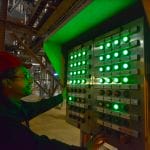The air pollution in India has been in its worst state ever. At one point in November 2016, air quality tests indicated that breathing in Delhi air is equivalent to smoking 44 cigarettes a day.
While scientists and engineers are working to reverse this, as well prevent the biggest cities to follow, there is not much that kids can do, right? Well, not actually.
Students in Shiv Nadar School in Noida, Uttar Pradesh have conducted air quality and lung capacity tests using kits that they developed on their own.
Grade six students monitored the deteriorating air quality in New Delhi through their innovative lung capacity test, designed using only a water can, a rubber tube, and a large container holding the water and can.

Photo via NDTV
Its purpose is to measure a person’s vital capacity, or the maximum amount of air a person can expel from the lungs after maximum inhalation. One hundred fifty six people in total were asked to blow inside the rubber tube, allowing water to displace out of the can.
The conclusion was that the lung capacity was very low in comparison to the ideal capacity level.
Meanwhile, the grade nine students gathered and tested the samples from the different heights of the atmosphere through a unique air collection mechanism.

Photo via Your Story
A grade nine student named Ridhima said, “We would constantly hear about rising air pollution around us and the toll it is taking on our health, but we were not able to quantify the magnanimity of the problem.
“So, to better understand the problem under the able guidance of our teachers we developed the lung capacity and air quality monitor tests using products that are easily available.”
Using a syringe, an arduino circuit, and hydrogen balloons, Ridhima and her classmates were able to collect air samples at 5 meters, 10 meters, 15 meters, 20 meters, 30 meters, and 40 meters from the ground.
It works by collecting the air inside the syringe connected with a circuit timed at various intervals.
The sample gathered were sent to the Central Pollution Control Board for analysis. It was discovered that every pollutant – Ozone (O3), Particulate matter (2.5 and 10), Carbon Monoxide (CO), Sulphur Dioxide (SO2), Nitrogen Dioxide (NO2) and the Air Quality Index (AQI) increased with height.
Moreover, the same group of students created a cost-effective prototype of air filter model and air humidifiers.
Source: Your Story
















